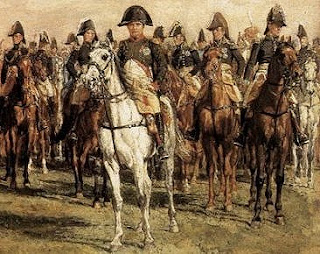2nd French corps surrender at Possneck
My worries about the player commitment in the PBEM campaign proved to be
unfounded. The campaign picked up again
after the long break to fight the three battles. These were the result of the three French
corps all attempting to establish themselves east of the river Saale at the
same time. The Russians counter
attacked and the result was three battles all starting on move 2 of the
campaign.
The French suffered a major defeat, and were driven back in
the centre. The north held, and the
south decided it was wiser to withdraw to the west bank the next morning. They were attacked as they before they could
do so. The resulting battle was pretty
even. Both corps had only suffered light
casualties the previous day, and the French were able to redeploy with their
backs to the river before the Russians could reach them.
However the adjacent Russian corps commander sent one of his
three divisions to “march to the sound of the guns”. This was unexpected by both the French and
Russian commanders involved in the fighting, and the first they knew of it was
when the new division arrived on the French left flank.
With six divisions already fighting on the table there was
not a lot of space for the new arrivals to deploy. They attacked the French left flank, and
sent their cavalry south to secure the only bridge over the river Saale and
prevent the French retreating.
With odds of four to three the end was entirely
predictable. The French fought to hold
the Russians until night, when they could slip back over the river under cover
of darkness. Bu t just before the end of
the battle the Russian cavalry reached the bridge and defeated the French
cavalry sent to hold it.
Meanwhile the French were fighting to withdraw to the
bridge. They lost heavily, particularly
amongst the rear guard. A mass of
French cavalry and infantry were struggling to cross the bridge when the
Russian cavalry arrived. The French
commander acknowledged defeat and surrendered.
It is the first time in more than 40 years war gaming that a
game has ended in the surrender of a whole corps. It is not the sort of thing you would set up
a “one off” wargame to achieve. It was
not pre planned in the PBEM campaign. It
highlights the advantage of allowing six players to plan their own campaign strategy
and allow them freedom to take risks.
It has produced one of the most interesting wargames we have ever
fought.
And it has provided a real interesting twist to the
campaign. If this were a solo campaign
I would end the Gera phase here and move on to the next phase of the
campaign. Given that the aim of the
campaign is to produce good wargames there would be little point in struggling
to continue with four Russian corps against three French. But it is not a solo campaign, and the
choice is not mine.
I have left the decision to the campaign players. The Russian commanders have, predictably,
all confirmed that they want to continue.
The French have not been so quick to respond. One of the three is now without a command,
but I have offered him the French reserve which I had run previously. A second has said he would like to continue,
but does not know what to do. A third
has not responded yet.
I do have a “clever plan” for the French. But it will be a lot of work to set up, and I
need to be sure that the French players are willing to continue in the
circumstances. If not, then I will have
to start work immediately on the next phase of the campaign. So all work has been suspended on the
proposed Italian campaign for the present.








